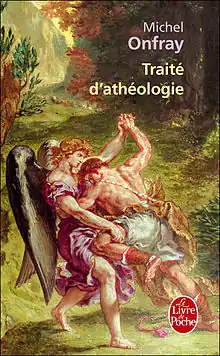Atheist Manifesto: The Case Against Christianity, Judaism, and Islam
Atheist Manifesto: The Case Against Christianity, Judaism, and Islam (French: Traité d'athéologie) is a 2005 book by French author Michel Onfray. According to Onfray, the term "athéologie" is taken from a project of a series of books written and compiled by Georges Bataille under the vocable La Somme athéologique, which was ultimately never completed.
 Jacob Wrestling with the Angel, by Delacroix, on the cover of the French-language paperback edition (Traité d'athéologie). | |
| Author | Michel Onfray |
|---|---|
| Country | France |
| Language | French |
| Subject | Atheism, criticism of religion |
| Publisher | Éditions Grasset |
Publication date | 2005 |
| Pages | 281 pp |
| ISBN | 2-246-64801-7 |
The book sold over 200,000 copies. Two other books were written shortly after its publication as replies to its arguments: L'Anti-traité d'athéologie, Le système Onfray mis à nu by Matthieu Baumier, and Dieu avec esprit: Réponse à Michel Onfray by Irène Fernandez.
The book was translated into English in 2007 with the titles Atheist Manifesto: The Case Against Christianity, Judaism, and Islam and In Defence of Atheism: The Case Against Christianity, Judaism and Islam.[1]
Summary
In the first part "Athéologie", the author develops Nietzsche's doctrine, but criticizing his view on the death of God. Then he shows how the concept of atheist was originally a pejorative connotation and concluded that the survival of Christianity in the form of Christian atheism on the Judeo-Christian morality. The second part "Monotheisme" is a structural analysis of the three Abrahamic religions in which the author highlights common features, including the contempt for the body and matter, denial of progress and science, misanthropy and hatred of the intellect. The third part "Christianisme" challenges the existence of Jesus which would be based on secondhand testimonies, asserts that the Apostle Paul, described as neurotic and hysterical, exploited the character of Jesus to lead the world in his hatred of the flesh, then explains how, opportunistically, Emperor Constantine made Christianity a state religion. In the last part "Théocratie", the author explains the relationship of the three monotheistic religions with political power, and describes their worst abuses. Then he shows several of contradictions in the sacred books and considers that these texts are often used to justify evil. He depicts Islam notably through the Iranian revolution and the regime of the Ayatollah Khomeini. The book concludes by proposing a new atheism or secularism that he called "post-Christian" or "post-modern" in which God and the morality which it relates are gone.[2]
Reception
The Institut d'études de l'Islam et des sciences du monde musulman (Institute for the Study of Islam and the Muslim World Science) stated: "Ultimately, the real inspiration of the Book of M[ichel] O[nfray] seems to lie in a kind of fashion, "the Black Book" and its corollary, the charge of totalitarianism. ( ... ) The information is mostly false or expected, and its function is to reinforce the frames of a thought on the rise: The Clash of Civilizations and the necessary fight against Islam."[2]
The Catholic magazine Esprit & Vie describes the Traité d'athéologie as an "atypical book, nourished by a visceral hatred against religion in general (...) It brings nothing fundamentally new compared to Nietzsche's work, if not the author's crazy contention to stand almost as the first true atheist."[3]
Amongst the "incalculable number of contradictions and improbabilities in the body of the text of the synoptic Gospels", two claims are made: crucifixion victims were not laid to rest in tombs, and in any case, Jews were not crucified in this period. John Dickson, from the Centre for Public Christianity, has said that Philo, writing about the time of Jesus, tells us that sometimes the Romans handed the bodies of crucifixion victims over to family members for proper burial. Josephus remarks: "the Jews are so careful about funeral rites that even malefactors who have been sentenced to crucifixion are taken down and buried before sunset".[4] Regarding the second claim, Dickson calls this a "clear historical blunder".[5]
By contrast, the journal of popular science Automates intelligents praised the book, saying it "reads like a novel. (...) In a very pleasing style, it takes on every aspect of the blindness and human evil produced by religions. (...) However, the journal also said: "It can be reproached to having limited to a critique of religion (...), but to have offered nothing concrete to the spirits who are in search of an alternative adapted to our times." "Scientific analysis of the belief" is missing. "We would have also appreciated that Michel Onfray mentions many modern scientists who honor the scientific materialism and atheism."[6]
See also
References
- Onfray, Michel, Atheist Manifesto: The Case Against Christianity, Judaism, and Islam, translated by Jeremy Leggatt, Arcade, 2007
- Héricord, Alex (31 May 2010). "Michel Onfray, Traité d'athéologie. Physique de la métaphysique". Institut d'études de l'Islam et des sciences du monde musulman (in French). Archived from the original on 20 July 2011. Retrieved 13 August 2010.
- Ledure, Yves (May 2005). "Traité d'athéologie". Esprit & Vie (in French). 128: 26–27. Archived from the original on 5 October 2010. Retrieved 13 August 2010.
- Josephus, The Jewish War, 4.317
- "Society for the Study of the Early Christianity - The Nouveau Atheists on the Historical Jesus" (PDF). Ancient History Documentary Research Centre. June 2008. Archived from the original (pdf) on 14 September 2009. Retrieved 13 August 2010.
- Baquiast, Jean-Paul (February 2005). "Traité d'athéologie". Automates intelligents (in French). Archived from the original on 14 June 2011. Retrieved 13 August 2010.